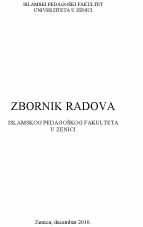KORIŠTENJE DEROGIRAJUĆIH I DEROGIRANIH AJETA (EN-NASIHU VEL-MENSUH) U HANDŽIĆEVOM TUMAČENJU KUR’ANA
THE USE OF DEROGATING AND DEROGATED AYATS (EN-NASIHU VEL-MENSUH) IN MEHMED HANDZIC`S INTERPRETATION OF THE QUR`AN
Author(s): Halil MehtićSubject(s): Education
Published by: Islamski pedagoški fakultet Univerziteta u Zenici
Keywords: Handžić; taffsir; derogating; derogated; ayat
Summary/Abstract: Reviewing Handžić`s interpretation of the Holy Qur`an and particularly the interpretation of Surah al-Baqarah and en-Nisa, we were able to verify the methodology that was followed. A general observation reveals that he based his methodology on nine principles. Among these principles he highly places derogating (nasih) and derogated (mensuh) ayats. Emphasizing the importance of knowing this taffsir branches in his "Introduction to Taffsir and Hadith science" Handzic points out that in Taffsir it is important to know derogating (nasih)and derogated (mensuh) ayats. He further explains that mensuh ayats are those ayats that contain shari'a regulations which were valid only for a limited time, and nasih ayats are those ayats that contain shari'a regulations which ruled out those temporary regulations contained in mensuh ayats. Shari'a regulations that are the part of nasih ayats are permanent and for all time. In this paper, we have selected a few examples that clearly illustrate the necessary principle which Handžić used in his interpretation of proper understanding of God's word.
Journal: Zbornik radova Islamskog pedagoškog fakulteta u Zenici
- Issue Year: 2010
- Issue No: 08
- Page Range: 119-129
- Page Count: 11
- Language: Bosnian

